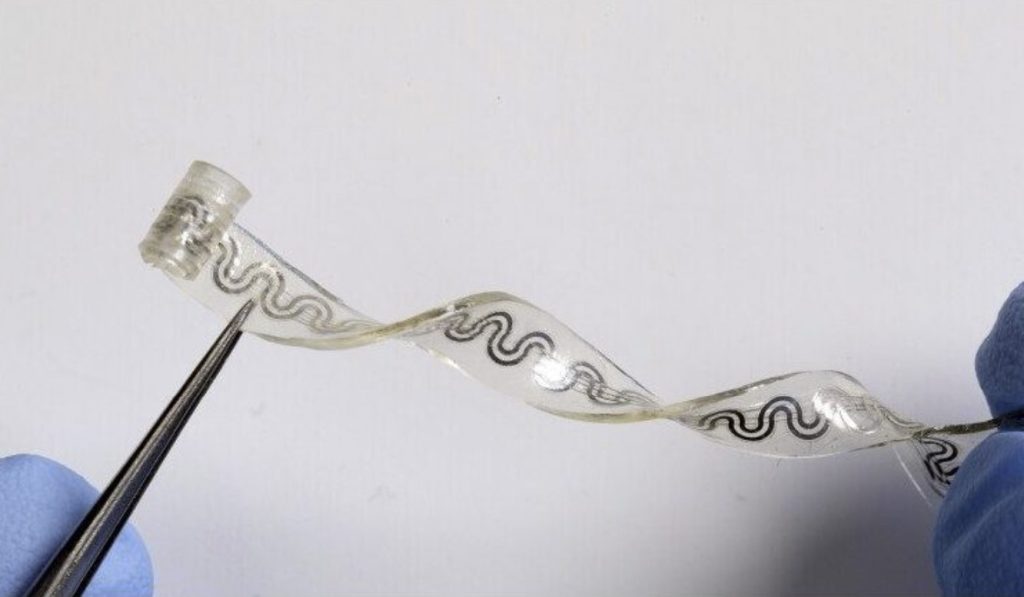
A Northwestern University-led team of researchers has developed a small, soft, flexible implant that relieves pain on demand and without the use of drugs. The first-of-its-kind device could provide a much-needed alternative to opioids and other highly addictive medications.
The biocompatible, water-soluble device works by softly wrapping around nerves to deliver precise, targeted cooling, which numbs nerves and blocks pain signals to the brain. An external pump enables the user to remotely activate the device and then increase or decrease its intensity. After the device is no longer needed, it naturally absorbs into the body — bypassing the need for surgical extraction.
Health Ranger Store: The healthiest superfoods to heal your body, your soul and the world…
The researchers believe the device will be most valuable for patients who undergo routine surgeries or even amputations that commonly require post-operative medications. Surgeons could implant the device during the procedure to help manage the patient’s post-operative pain.
“Although opioids are extremely effective, they also are extremely addictive,” said Northwestern’s John A. Rogers, who led the device’s development. “As engineers, we are motivated by the idea of treating pain without drugs — in ways that can be turned on and off instantly, with user control over the intensity of relief. The technology reported here exploits mechanisms that have some similarities to those that cause your fingers to feel numb when cold.
“Our implant allows that effect to be produced in a programmable way, directly and locally to targeted nerves, even those deep within surrounding soft tissues.”
How it works
Although the new device might sound like science fiction, it leverages a simple, common concept that everyone knows: evaporation. Similar to how evaporating sweat cools the body, the device contains a liquid coolant that is induced to evaporate at the specific location of a sensory nerve.
“As you cool down a nerve, the signals that travel through the nerve become slower and slower — eventually stopping completely,” said study coauthor Dr. Matthew MacEwan of Washington University School of Medicine in St. Louis. “We are specifically targeting peripheral nerves, which connect your brain and your spinal cord to the rest of your body. These are the nerves that communicate sensory stimuli, including pain. By delivering a cooling effect to just one or two targeted nerves, we can effectively modulate pain signals in one specific region of the body.”
To induce the cooling effect, the device contains tiny microfluidic channels. One channel contains the liquid coolant (perfluoropentane), which is already clinically approved as an ultrasound contrast agent and for pressurized inhalers. A second channel contains dry nitrogen, an inert gas.
When the liquid and gas flow into a shared chamber, a reaction occurs that causes the liquid to promptly evaporate. Simultaneously, a tiny integrated sensor monitors the temperature of the nerve to ensure that it’s not getting too cold, which could cause tissue damage.
You will never go without electricity with this portable power station…
“Excessive cooling can damage the nerve and the fragile tissues around it,” Rogers said. “The duration and temperature of the cooling must therefore be controlled precisely. By monitoring the temperature at the nerve, the flow rates can be adjusted automatically to set a point that blocks pain in a reversible, safe manner.”
Precision power
While other cooling therapies and nerve blockers have been tested experimentally, all have limitations that the new device overcomes. Previously researchers have explored cryotherapies, for example, which are injected with a needle. Instead of targeting specific nerves, these imprecise approaches cool large areas of tissue, potentially leading to unwanted effects such as tissue damage and inflammation.
At its widest point, Northwestern’s tiny device is just 5 millimeters wide. One end is curled into a cuff that softly wraps around a single nerve, bypassing the need for sutures. By precisely targeting only the affected nerve, the device spares surrounding regions from unnecessary cooling, which could lead to side effects.
“You don’t want to inadvertently cool other nerves or the tissues that are unrelated to the nerve transmitting the painful stimuli,” MacEwan said. “We want to block the pain signals, not the nerves that control motor function and enables you to use your hand, for example.”
Previous researchers also have explored nerve blockers that use electrical stimulation to silence painful stimuli. These, too, have limitations.
“You can’t shut down a nerve with electrical stimulation without activating it first,” MacEwan said. “That can cause additional pain or muscle contractions and is not ideal, from a patient’s perspective.”
Disappearing act
This new technology is the third example of bioresorbable electronic devices from the Rogers lab, which introduced the concept of transient electronics in 2012, published in Science.
In 2018, Rogers, MacEwan and colleagues demonstrated the world’s first bioresorbable electronic device — a biodegradable implant that speeds nerve regeneration.
Then, in 2021, Rogers and colleagues introduced a transient pacemaker.
All components of the devices are biocompatible and naturally absorb into the body’s biofluids over the course of days or weeks, without needing surgical extraction. The bioresorbable devices are completely harmless — similar to absorbable stitches.
Drink clean water at home… Get this filter now…
At the thickness of a sheet of paper, the soft, elastic nerve cooling device is ideal for treating highly sensitive nerves.
“If you think about soft tissues, fragile nerves and a body that’s in constant motion, any interfacing device must have the ability to flex, bend, twist and stretch easily and naturally,” Rogers said. “Furthermore, you would like the device to simply disappear after it is no longer needed, to avoid delicate and risky procedures for surgical removal.” [Science, Nature 1, Nature 2]
StrangeSounds.org has been banned from ad networks and is now entirely reader-supported CLICK HERE TO SUPPORT MY WORK… I will send you a small gemstone if you give more than 25$… Thanks in advance!
Here some things to add to your disaster & preparedness kit:
- Protect your home and car with the best EMP, solar flares and lightning shield available…
- Drink clean water at home… Get this filter now…
- Health Ranger Store: Buy Clean Food and Products to heal the world…
- Prepare your retirement by investing in GOLD, SILVER and other PRECIOUS METALS…
- You will ALWAYS have electricity with this portable SOLAR power station…
- Qfiles is another great site for alternative news and information…













And where is the fun in that!?
food riots are coming , strange sounds we can not comment on other platform of your site.. Pleae can you put stories in both or show us solutions please Commander SS.
No thanks, everything we need to heal us, body, mind and soul comes from the earth.
Hmmm, probably would be a good treatment for sciatic nerve pain, but based upon the new modern medicine and pharma-sorcery, I would be inclined to keep doing what I do to treat sciatica; that is, apply pressure to nerve, hold for 30 seconds, and pray to Christ and the healing angels to eradicate the pain. I don’t believe in pills or drugs for pain either. Nor booze. Probably why I am grumpy at times.